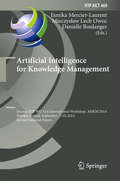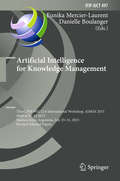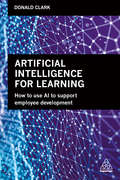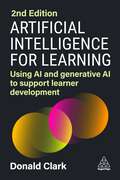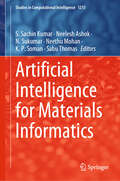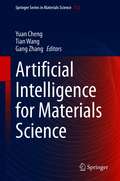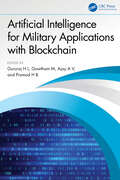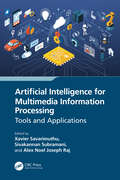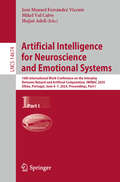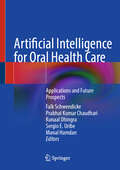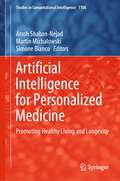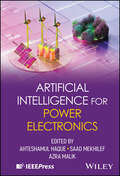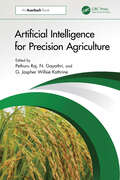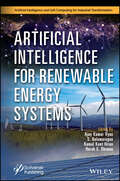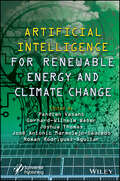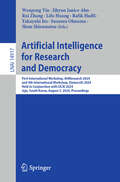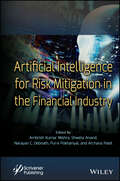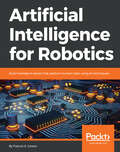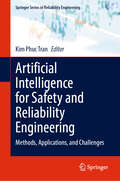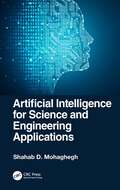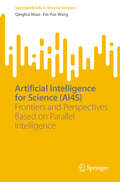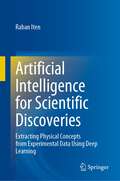- Table View
- List View
Artificial Intelligence for Knowledge Management: Second IFIP WG 12.6 International Workshop, AI4KM 2014, Warsaw, Poland, September 7-10, 2014, Revised Selected Papers (IFIP Advances in Information and Communication Technology #469)
by Eunika Mercier-Laurent Mieczysław Lech Owoc Danielle BoulangerThis book features a selection of papers presented at the Second IFIP WG 12. 6 International Workshop on Artificial Intelligence for Knowledge Management, AI4KM 2014, held in Wroclaw, Poland, in September 2014, in the framework of the Federated Conferences on Computer Science and Information Systems, FedCSIS 2014. The 9 revised and extended papers and one invited paper were carefully reviewed and selected for inclusion in this volume. They present new research and innovative aspects in the field of knowledge management and are organized in the following topical sections: tools and methods for knowledge acquisition; models and functioning of knowledge management; techniques of artificial intelligence supporting knowlege management; and components of knowledge flow.
Artificial Intelligence for Knowledge Management: Third IFIP WG 12.6 International Workshop, AI4KM 2015, Held at IJCAI 2015, Buenos Aires, Argentina, July 25-31, 2015, Revised Selected Papers (IFIP Advances in Information and Communication Technology #497)
by Eunika Mercier-Laurent and Danielle BoulangerThis book features a selection of papers presented at the Third IFIP WG 12.6 International Workshop on Artificial Intelligence for Knowledge Management, AI4KM 2015, held in Buenos Aires, Argentina, in July 2015, in the framework of the International Joint Conference on Artificial Intelligence, IJCAI 2015. The 9 revised and extended papers were carefully reviewed and selected from 15 submissions. They present new research and innovative aspects in the field of knowledge management such as knowledge models, KM and Web, knowledge capturing and learning, and KM and AI intersections.
Artificial Intelligence for Learning: How to use AI to Support Employee Development
by Donald ClarkArtificial intelligence is creating huge opportunities for workplace learning and employee development. However, it can be difficult for L&D professionals to assess what difference AI can make in their organization and where it is best implemented. Artificial Intelligence for Learning is the practical guide L&D practitioners need to understand what AI is and how to use it to improve all aspects of learning in the workplace. It includes specific guidance on how AI can provide content curation and personalization to improve learner engagement, how it can be implemented to improve the efficiency of evaluation, assessment and reporting and how chatbots can provide learner support to a global workforce.Artificial Intelligence for Learning debunks the myths and cuts through the hype around AI allowing L&D practitioners to feel confident in their ability to critically assess where artificial intelligence can make a measurable difference and where it is worth investing in. There is also critical discussion of how AI is an aid to learning and development, not a replacement as well as how it can be used to boost the effectiveness of workplace learning, reduce drop off rates in online learning and improve ROI. With real-world examples from companies who have effectively implemented AI and seen the benefits as well as case studies from organizations including Netflix, British Airways and the NHS, this book is essential reading for all L&D practitioners needing to understand AI and what it means in practice.
Artificial Intelligence for Learning: Using AI and Generative AI to Support Learner Development
by Donald ClarkWith Artificial Intelligence (AI) creating huge opportunities for learning and employee development, how can learning professionals best implement the use of AI into their environment?Artificial Intelligence for Learning is the essential guide for learning professionals who want to understand how to use AI to improve all aspects of learning in organizations. This new edition debunks the myths and misconceptions around AI, discusses the learning theory behind generative AI and gives strategic and practical advice on how AI can be used.This book also includes specific guidance on how AI can provide learning support, chatbot functionality and content, as well as ideas on ethics and personalization. This book is necessary reading for all learning practitioners needing to understand AI and what it means in practice.
Artificial Intelligence for Marketing Management (Routledge Studies in Marketing)
by Park Thaichon Sara QuachArtificial intelligence (AI) has driven businesses to adopt new business practices rapidly, enhance product development and services, has helped to power AI-based market intelligence and customer insights, and improve customer relationship management. This timely book addresses the use of AI in marketing. This book also explores the dark side of AI in marketing management and discusses ethics and transparency of automated decision-making in AI applications, data privacy, cyber security issues, and biases in various facets of marketing. Emerging applications of AI such as DeepFakes which use deep learning technology could increase risks of manipulation and deception. Hence, apart from leveraging AI capabilities and advantages, the book cautions the need for prevention strategies to deal with potential issues that could arise from the adoption of AI in marketing management. This book will provide practical insights into the role of AI in marketing management. It will be a useful reference for those researching marketing and marketing professionals.
Artificial Intelligence for Materials Informatics (Studies in Computational Intelligence #1213)
by Sabu Thomas N. Sukumar S. Sachin Kumar Neelesh Ashok Neethu Mohan K. P. SomanThis comprehensive book explores the transformative impact of AI on materials informatics, delving into machine learning/deep learning, and material knowledge representation. Embracing the transformative power of artificial intelligence (AI), the field of materials informatics has witnessed a remarkable revolution in its methodology and applications. AI has revolutionized the field of materials informatics, enabling researchers to discover, design, and optimize materials with enhanced properties at an accelerated pace. It showcases how AI is accelerating materials discovery, property prediction, providing case studies, and a comprehensive bibliography for further exploration. This essential resource equips researchers, scientists, and engineers with the knowledge and tools to harness the power of AI for groundbreaking advancements in materials science.
Artificial Intelligence for Materials Science (Springer Series in Materials Science #312)
by Yuan Cheng Gang Zhang Tian WangMachine learning methods have lowered the cost of exploring new structures of unknown compounds, and can be used to predict reasonable expectations and subsequently validated by experimental results. As new insights and several elaborative tools have been developed for materials science and engineering in recent years, it is an appropriate time to present a book covering recent progress in this field.Searchable and interactive databases can promote research on emerging materials. Recently, databases containing a large number of high-quality materials properties for new advanced materials discovery have been developed. These approaches are set to make a significant impact on human life and, with numerous commercial developments emerging, will become a major academic topic in the coming years. This authoritative and comprehensive book will be of interest to both existing researchers in this field as well as others in the materials science community who wish to take advantage of these powerful techniques. The book offers a global spread of authors, from USA, Canada, UK, Japan, France, Russia, China and Singapore, who are all world recognized experts in their separate areas. With content relevant to both academic and commercial points of view, and offering an accessible overview of recent progress and potential future directions, the book will interest graduate students, postgraduate researchers, and consultants and industrial engineers.
Artificial Intelligence for Military Applications with Blockchain
by Gowtham M Gururaj H L Ajay A V Pramod H BIn an era where advanced technology plays a critical role in maintaining national security, Artificial Intelligence for Military Applications with Blockchain investigates how combining AI and blockchain could transform military operations. This comprehensive guide offers creative answers for contemporary military problems while addressing the most important defense-related concerns, from data security to decision-making.It explores constrained networking middleware for defense applications, guaranteeing smooth communication under critical circumstances. This book starts with an in-depth examination of blockchain’s potential to improve document management across defense departments, then moves to a detailed discussion of security and privacy in military applications. The integration of AI and blockchain in military context is then the main topic of discussion, along with its advantages, disadvantages, and real-time applications.The potential of blockchain and AI to protect data and streamline operations is also explored, providing readers with insights into the military and healthcare sectors. This book offers a thorough examination of the military’s current and future use of AI, as well as a breakdown of cybersecurity issues and how blockchain technology is being used to improve military cybersecurity. A dedicated chapter examines the ways in which blockchain technology is being used by computational intelligence to transform the defense environment.Key features: Examines privacy and security issues in military blockchain applications Investigates military operations using constrained networking middleware Discusses integrating AI and blockchain technology for military applications Includes case studies of blockchain and AI uses in the military and healthcare Thoroughly examines cybersecurity issues and how blockchain technology can help This book is essential for military personnel, defense academics, and cybersecurity specialists interested in the use of AI and blockchain for defense. It presents real-world examples and case studies together with an outlook on how these technologies will influence future military operations.
Artificial Intelligence for Multimedia Information Processing: Tools and Applications
by Xavier Savarimuthu Sivakannan Subramani Alex Noel Joseph RajAdvances in artificial intelligence (AI), widespread mobile devices, internet technologies, multimedia data sources, and information processing have led to the emergence of multimedia processing. Multimedia processing is the application of signal processing tools to multimedia data—text, audio, images, and video—to allow the interpretation of these data, particularly in urban and smart city environments. This book discusses the new standards of multimedia and information processing from several technological perspectives, including analytics empowered by AI, streaming on the intelligent edge, multimedia edge caching and AI, services for edge AI, and hardware and devices for multimedia on edge intelligence.FEATURES Covers a wide spectrum of enabling technologies for AI and machine learning for multimedia and information processing Includes many applications using AI, from robotics and driverless cars to environmental, human health, and remote sensing Presents an overview of the fundamentals of AI and multimedia processing: imaging, signal, and speech Explains new models and architectures for multimedia streaming, services, and caching for AI Discusses the emerging paradigms of the deployment of hardware and devices for multimedia on edge intelligence Gives recommendations for future research in multimedia and AI This book is written for engineers and graduate students in image and signal processing, information processing, environmental engineering, medical and public health, etc., who are interested in machine learning, deep learning, and multimedia processing.
Artificial Intelligence for Neuroscience and Emotional Systems: 10th International Work-Conference on the Interplay Between Natural and Artificial Computation, IWINAC 2024, Olhâo, Portugal, June 4–7, 2024, Proceedings, Part I (Lecture Notes in Computer Science #14674)
by Hojjat Adeli José Manuel Ferrández Vicente Mikel Val CalvoThe two volume set LNCS 14674 and 14675 constitutes the proceedings of the 10th International Work-Conference on the Interplay Between Natural and Artificial Computation, IWINAC 2024, which took place in Olhâo, Portugal, during June 4–7, 2024. The 99 full papers presented in these proceedings were carefully reviewed and selected from 193 submissions. They were organized in topical sections as follows: Part I: Machine learning in neuroscience; artificial intelligence in neurophysiology; neuromotor and cognitive disorders; intelligent systems for assessment, treatment, and assistance in early stages of Alzheimer's disease and other dementias; socio-cognitive, affective and physiological computing; affective computing and context awareness in ambientintelliigence; learning tools to lecture; Part II: Machine learning in computer vision and robotics; bio-inspired computing approaches; social and civil engineering through human AI translations; smart renewable energies: advancing AI algorithms in the renewable energy industry; bioinspired applications.
Artificial Intelligence for Oral Health Care: Applications and Future Prospects
by Falk Schwendicke Prabhat Kumar Chaudhari Kunaal Dhingra Sergio E. Uribe Manal HamdanArtificial intelligence (AI) is reshaping diagnostics, treatment planning, and patient care across diverse disciplines. Dentistry is now at the forefront of this innovation, with AI's ability to process complex data to improve clinical practice, empower patients, and address public health challenges. This richly illustrated book offers a deeper understanding of the foundational concepts of AI, its practical applications in oral health, and the possibilities that lie ahead. From oral pathology to maxillofacial surgery, prosthodontics to orthodontics, and endodontics to dental education, it presents compelling, evidence-based insights into how AI is changing the landscape of dentistry. Beyond its clinical potential, the book tackles the key risks and challenges associated with AI implementation. It provides a thoughtful roadmap for addressing ethical considerations, encouraging transparency, and developing solutions that prioritize both innovation and patient well-being. Written for dental professionals and an interdisciplinary audience, including educators, researchers, policymakers, and the public, this book serves as both a guide and a call to action for responsibly embracing AI's transformative power. Whether you are a seasoned practitioner, an academic, or simply curious about the intersection of AI and healthcare, this book will inspire and inform your journey into the future of dentistry.
Artificial Intelligence for Personalized Medicine: Promoting Healthy Living and Longevity (Studies in Computational Intelligence #1106)
by Simone Bianco Arash Shaban-Nejad Martin MichalowskiThis book aims to highlight the latest achievements in the use of AI in personalized medicine and healthcare delivery. The edited book contains selected papers presented at the 2023 Health Intelligence workshop, co-located with the Thirty-Seven Association for the Advancement of Artificial Intelligence (AAAI) conference, and presents an overview of the issues, challenges, and potentials in the field, along with new research results. This book provides information for researchers, students, industry professionals, clinicians, and public health agencies interested in the applications of AI in medicine and public health.
Artificial Intelligence for Power Electronics
by Saad Mekhilef Ahteshamul Haque Azra MalikThorough review of how artificial intelligence can enhance the design, control, and optimization of power electronics systems Artificial Intelligence for Power Electronics provides a comprehensive overview of the intersection between artificial intelligence (AI) and the field of power electronics, exploring how AI can revolutionize and enhance the design, control, and optimization of power electronics systems. The book covers the fundamentals of AI, the fundamentals of power electronics and the challenges the field faces in design to production, and the solutions of these challenges through AI methods. Example solutions, along with Q&A review sections, are included throughout the text, with coverage of both Python and MATLAB. Topics discussed in Artificial Intelligence for Power Electronics include: Supervised, unsupervised, and reinforcement machine learning and the role of data in training machine learning modelsTechniques for AI data collection in power electronics and how to clean, normalize, and handle missing values of dataOptimization techniques such as Particle Swarm Optimization and Ant Colony OptimizationDetection techniques for identifying faults and anomalies and clustering algorithms to group similar operational behaviorEssential Python libraries for machine learning and how to perform machine learning on a Raspberry Pi Delivering an industry-specific approach to AI applications, Artificial Intelligence for Power Electronics is a helpful reference for undergraduate, postgraduate, and PhD students in electrical, electronic, and computer engineering. Mechanical engineers and other industry professionals may also find it valuable.
Artificial Intelligence for Precision Agriculture
by Pethuru Raj N. Gayathri Kathrine, G. Jaspher WillsiePrecision agriculture is a next-generation farming management concept that optimizes resource use, productivity, quality, profitability, and sustainability by observing and responding to crop variability. Precision agriculture employs digital technologies such as the Internet of Things (IoT), artificial intelligence (AI), 5G communication, cybersecurity, edge computing, cloud-native principles, and blockchain to ensure crops and soil receive exactly what they need for optimal health and productivity.Artificial Intelligence for Precision Agriculture explores the latest developments in precision agriculture, detailing how AI contributes to its goals. The book discusses how precision agriculture solutions use IoT devices, data storage, AI analytics, connectivity, and cloud infrastructures to analyze factors such as soil type, terrain, weather, plant growth, and yield data. It also examines edge technologies—sensors, microchips, beacons, RFID tags, robots, drones, and actuators—that collect field data and transmit it to cloud-based AI platforms for analysis. The book shows how AI-driven insights guide actions in the field, such as crop rotation, optimal planting and harvesting times, and soil management, and help farmers apply the right amounts of water, fertilizers, and pesticides, reducing waste and environmental impact. Applications covered in the book include: Drone-based high-resolution field mapping Tracking crops Crop yield assessments Data collection for irrigation, fertilization, and crop management Advanced weather monitoring Equipment management With chapters on AI model development, plant disease detection and remediation, sustainable farming techniques, data integration, AI-enabled data analytics, and knowledge visualization, this book is a comprehensive guide to technologies and applications in precision agriculture.
Artificial Intelligence for Renewable Energy Systems (Artificial Intelligence and Soft Computing for Industrial Transformation)
by S. Balamurugan Ajay Kumar Vyas Kamal Kant Hiran Harsh S. DhimanARTIFICIAL INTELLIGENCE FOR RENEWABLE ENERGY SYSTEMS Renewable energy systems, including solar, wind, biodiesel, hybrid energy, and other relevant types, have numerous advantages compared to their conventional counterparts. This book presents the application of machine learning and deep learning techniques for renewable energy system modeling, forecasting, and optimization for efficient system design. Due to the importance of renewable energy in today’s world, this book was designed to enhance the reader’s knowledge based on current developments in the field. For instance, the extraction and selection of machine learning algorithms for renewable energy systems, forecasting of wind and solar radiation are featured in the book. Also highlighted are intelligent data, renewable energy informatics systems based on supervisory control and data acquisition (SCADA); and intelligent condition monitoring of solar and wind energy systems. Moreover, an AI-based system for real-time decision-making for renewable energy systems is presented; and also demonstrated is the prediction of energy consumption in green buildings using machine learning. The chapter authors also provide both experimental and real datasets with great potential in the renewable energy sector, which apply machine learning (ML) and deep learning (DL) algorithms that will be helpful for economic and environmental forecasting of the renewable energy business. Audience The primary target audience includes research scholars, industry engineers, and graduate students working in renewable energy, electrical engineering, machine learning, information & communication technology.
Artificial Intelligence for Renewable Energy and Climate Change
by Pandian Vasant Gerhard-Wilhelm Weber José Antonio Marmolejo-Saucedo Roman Rodriguez-Aguilar Joshua ThomasARTIFICIAL INTELLIGENCE FOR RENEWABLE ENERGY AND CLIMATE CHANGE Written and edited by a global team of experts in the field, this groundbreaking new volume presents the concepts and fundamentals of using artificial intelligence in renewable energy and climate change, while also covering the practical applications that can be utilized across multiple disciplines and industries, for the engineer, the student, and other professionals and scientists. Renewable energy and climate change are two of the most important and difficult issues facing the world today. The state of the art in these areas is changing rapidly, with new techniques and theories coming online seemingly every day. It is important for scientists, engineers, and other professionals working in these areas to stay abreast of developments, advances, and practical applications, and this volume is an outstanding reference and tool for this purpose. The paradigm in renewable energy and climate change shifts constantly. In today’s international and competitive environment, lean and green practices are important determinants to increase performance. Corresponding production philosophies and techniques help companies diminish lead times and costs of manufacturing, improve delivery on time and quality, and at the same time become more ecological by reducing material use and waste, and by recycling and reusing. Those lean and green activities enhance productivity, lower carbon footprint and improve consumer satisfaction, which in reverse makes firms competitive and sustainable. This practical, new groundbreaking volume: Features coverage on a wide range of topics such as classical and nature-inspired optimization and optimal control, hybrid and stochastic systems Is ideally designed for engineers, scientists, industrialist, academicians, researchers, computer and information technologists, sustainable developers, managers, environmentalists, government leaders, research officers, policy makers, business leaders and students Is useful as a practical tool for practitioners in the fields of sustainable and renewable energy sustainability Includes wide coverage of how artificial intelligence can be used to impact the struggle against global warming and climate change
Artificial Intelligence for Research and Democracy: First International Workshop, AI4Research 2024, and 4th International Workshop, DemocrAI 2024, Held in Conjunction with IJCAI 2024, Jeju, South Korea, August 5, 2024, Proceedings (Lecture Notes in Computer Science #14917)
by Takayuki Ito Rafik Hadfi Rui Zhang Wenpeng Yin Jihyun Janice Ahn Lifu Huang Susumu Ohnuma Shun ShiramatsuThis book constitutes the proceedings of the First International workshop on AI for Research, AI4Research 2024, and 4th International workshop on Democracy and AI, DemocrAI 2024, held in conjunction with the 33rd International Joint Conference on Artificial Intelligence, IJCAI 2024, in Jeju, South Korea, in August 2024. The 9 papers presented here were carefully reviewed and selected from 34 submissions. The AI4Research 2024 proceedings focus on how recent developments in AI are influencing research across various fields in science. The DemocrAI 2024 proceedings focus on the use of AI-based systems in Democracy, especially Democratic online platforms, formal theories of collective decision-making, and advanced methodologies for discourse analysis.
Artificial Intelligence for Risk Mitigation in the Financial Industry
by Narayan C. Debnath Archana Patel Purvi Pokhariyal Shweta Anand Ambrish Kumar MishraArtificial Intelligence for Risk Mitigation in the Financial Industry This book extensively explores the implementation of AI in the risk mitigation process and provides information for auditing, banking, and financial sectors on how to reduce risk and enhance effective reliability. The applications of the financial industry incorporate vast volumes of structured and unstructured data to gain insight into the financial and non-financial performance of companies. As a result of exponentially increasing data, auditors and management professionals need to enhance processing capabilities while maintaining the effectiveness and reliability of the risk mitigation process. The risk mitigation and audit procedures are processes involving the progression of activities to “transform inputs into output.” As AI systems continue to grow mainstream, it is difficult to imagine an aspect of risk mitigation in the financial industry that will not require AI-related assurance or AI-assisted advisory services. AI can be used as a strong tool in many ways, like the prevention of fraud, money laundering, and cybercrime, detection of risks and probability of NPAs at early stages, sound lending, etc. Audience This is an introductory book that provides insights into the advantages of risk mitigation by the adoption of AI in the financial industry. The subject is not only restricted to individuals like researchers, auditors, and management professionals, but also includes decision-making authorities like the government. This book is a valuable guide to the utilization of AI for risk mitigation and will serve as an important standalone reference for years to come.
Artificial Intelligence for Robotics and Autonomous Systems Applications (Studies in Computational Intelligence #1093)
by Anis Koubaa Ahmad Taher AzarThis book addresses many applications of artificial intelligence in robotics, namely AI using visual and motional input. Robotic technology has made significant contributions to daily living, industrial uses, and medicinal applications. Machine learning, in particular, is critical for intelligent robots or unmanned/autonomous systems such as UAVs, UGVs, UUVs, cooperative robots, and so on. Humans are distinguished from animals by capacities such as receiving visual information, adjusting to uncertain circumstances, and making decisions to take action in a complex system. Significant progress has been made in robotics toward human-like intelligence; yet, there are still numerous unresolved issues. Deep learning, reinforcement learning, real-time learning, swarm intelligence, and other developing approaches such as tiny-ML have been developed in recent decades and used in robotics.Artificial intelligence is being integrated into robots in order to develop advanced robotics capable of performing multiple tasks and learning new things with a better perception of the environment, allowing robots to perform critical tasks with human-like vision to detect or recognize various objects. Intelligent robots have been successfully constructed using machine learning and deep learning AI technology. Robotics performance is improving as higher quality, and more precise machine learning processes are used to train computer vision models to recognize different things and carry out operations correctly with the desired outcome.We believe that the increasing demands and challenges offered by real-world robotic applications encourage academic research in both artificial intelligence and robotics. The goal of this book is to bring together scientists, specialists, and engineers from around the world to present and share their most recent research findings and new ideas on artificial intelligence in robotics.
Artificial Intelligence for Robotics: Build intelligent robots that perform human tasks using AI techniques
by Francis X. GoversBring a new degree of interconnectivity to your world by building your own intelligent robots Key Features Leverage fundamentals of AI and robotics Work through use cases to implement various machine learning algorithms Explore Natural Language Processing (NLP) concepts for efficient decision making in robots Book Description Artificial Intelligence for Robotics starts with an introduction to Robot Operating Systems (ROS), Python, robotic fundamentals, and the software and tools that are required to start out with robotics. You will learn robotics concepts that will be useful for making decisions, along with basic navigation skills. As you make your way through the chapters, you will learn about object recognition and genetic algorithms, which will teach your robot to identify and pick up an irregular object. With plenty of use cases throughout, you will explore natural language processing (NLP) and machine learning techniques to further enhance your robot. In the concluding chapters, you will learn about path planning and goal-oriented programming, which will help your robot prioritize tasks. By the end of this book, you will have learned to give your robot an artificial personality using simulated intelligence. What you will learn Get started with robotics and artificial intelligence Apply simulation techniques to give your robot an artificial personality Understand object recognition using neural networks and supervised learning techniques Pick up objects using genetic algorithms for manipulation Teach your robot to listen using NLP via an expert system Use machine learning and computer vision to teach your robot how to avoid obstacles Understand path planning, decision trees, and search algorithms in order to enhance your robot Who this book is for If you have basic knowledge about robotics and want to build or enhance your existing robot's intelligence, then Artificial Intelligence for Robotics is for you. This book is also for enthusiasts who want to gain knowledge of AI and robotics.
Artificial Intelligence for Safety and Reliability Engineering: Methods, Applications, and Challenges (Springer Series in Reliability Engineering)
by Kim Phuc TranThis book is a comprehensive exploration of the latest theoretical research, technological advancements, and real-world applications of artificial intelligence (AI) for safety and reliability engineering. Smart manufacturing relies on predictive maintenance (PdM) to ensure sustainable production systems, and the integration of AI has become increasingly prevalent in this field. This book serves as a valuable resource for researchers, practitioners, and decision-makers in manufacturing. By combining theoretical research, practical applications, and case studies, it equips readers with the necessary knowledge and tools to implement AI for safety and reliability engineering effectively in smart manufacturing contexts.
Artificial Intelligence for Science and Engineering Applications
by Shahab D. MohagheghArtificial Intelligence (AI) is defined as the simulation of human intelligence through the mimicking of the human brain for analysis, modeling, and decision‑making. Science and engineering problem solving requires modeling of physical phenomena, and humans approach the solution of scientific and engineering problems differently from other problems. Artificial Intelligence for Science and Engineering Applications addresses the unique differences in how AI should be developed and used in science and engineering. Through the inclusion of definitions and detailed examples, this book describes the actual and realistic requirements as well as what characteristics must be avoided for correct and successful science and engineering applications of AI.This book:• Offers a brief history of AI and covers science and engineering applications• Explores the modeling of physical phenomena using AI• Discusses explainable AI (XAI) applications• Covers the ethics of AI in science and engineering• Features real‑world case studiesOffering a probing view into the unique nature of scientific and engineering exploration, this book will be of interest to generalists and experts looking to expand their understanding of how AI can better tackle and advance technology and developments in scientific and engineering disciplines.
Artificial Intelligence for Science: Frontiers and Perspectives Based on Parallel Intelligence (SpringerBriefs in Service Science)
by Fei-Yue Wang Qinghai MiaoThis book presents a comprehensive framework for analyzing, evaluating, and guiding AI for Sciences (AI4Sci) research, offering a unified approach that facilitates analysis across various academic fields through a shared set of dimensions and indicators. It provides a systematic overview of recent AI4Sci advances in various disciplines and offers insights into the latest issues in and prospects of AI4Sci. The book is based on the theory of Parallel Intelligence (PI), which forms the foundation for the general AI4Sci framework. By analyzing multiple cases in various academic fields, this framework integrates key elements of AI4Sci, such as real scientific problems, datasets, virtual systems, AI methods, human roles, and organizational mechanisms, from a multidimensional perspective. It also assesses and summarizes the limitations of AI4Sci, incorporating the latest advances in AI for fundamental models. Lastly, it explores the impact of DeSci and DAO, as well as TAO, on AI4Sci ecosystem development and prospects. Through its balanced approach, the book offers readers a goal-oriented perspective, focusing on a concise presentation of the core ideas and reducing detailed descriptions of specific AI4Sci cases to a minimum.
Artificial Intelligence for Scientific Discoveries: Extracting Physical Concepts from Experimental Data Using Deep Learning
by Raban ItenWill research soon be done by artificial intelligence, thereby making human researchers superfluous? This book explains modern approaches to discovering physical concepts with machine learning and elucidates their strengths and limitations. The automation of the creation of experimental setups and physical models, as well as model testing are discussed. The focus of the book is the automation of an important step of the model creation, namely finding a minimal number of natural parameters that contain sufficient information to make predictions about the considered system. The basic idea of this approach is to employ a deep learning architecture, SciNet, to model a simplified version of a physicist's reasoning process. SciNet finds the relevant physical parameters, like the mass of a particle, from experimental data and makes predictions based on the parameters found. The author demonstrates how to extract conceptual information from such parameters, e.g., Copernicus' conclusion that the solar system is heliocentric.
Artificial Intelligence for Security: Enhancing Protection in a Changing World
by Tuomo Sipola Tero Kokkonen Janne Alatalo Monika WolfmayrThis book discusses the use of artificial intelligence (AI) for security purposes. It is divided into three parts: methodological fundamentals of AI, use of AI for critical infrastructure protection and anomaly detection. The first section describes the latest knowledge for creating safe AIs and using them to enhance protection. This book also presents various domains and examples of AI-driven security. The chapters describe potential methods, demonstrate use cases and discuss the challenges of the evolving field. This includes topics such as defensive use of AI to detect threats. It discusses the offensive use of AI to better understand the future threat landscape, the use of AI for automation in critical infrastructure and overall challenges of AI usage for critical tasks. As new threats emerge, the use of AI technologies to protect the world one lives in is topical. New technologies in this space have advanced rapidly, and subsequently, their use in enhancing protection is an evident development. To this effect, this book brings together a group of international researchers and professionals who present their views on how to create security through AI. This book targets postgraduate students, researchers and professionals who want to understand the use of AI for security. Understanding latest advancements in this field will also be useful to those who want to comprehend modern cybersecurity in detail and who want to follow research and latest trends.
